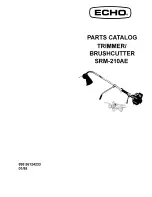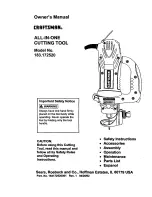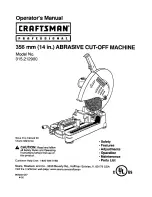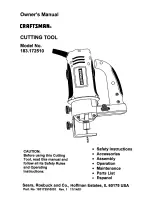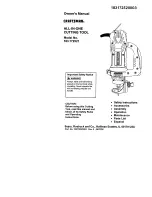
17
English
GB
F
D
E
I
P
NL
S
DK
N
FIN GR
HU
CZ
RU
RO
PL SLO HR
TR EST
LT
LV
SK
BG
17
SPECIFIC SAFETY RULES
■
After engine stops, keep rotating blade in heavy grass
or pulpy weeds until it stops.
■
Do not operate the brush cutter unless the blade
guard is firmly secured in place and in good
condition.
■
Use heavy gloves while installing or removing blades.
■
Always stop the engine and remove the spark plug
wire before attempting to remove any obstruction
caught or jammed in the blade or before removing
and installing the blade.
■
Do not attempt to touch or stop the blade when it is
rotating.
■
A coasting blade can cause injury while it continues
to spin after the engine is stopped or throttle trigger
released. Maintain proper control until the blade has
completely stopped rotating.
■
Replace any blade that has been damaged. Always
make sure blade is installed correctly and securely
fastened before each use.
■
Use only the manufacturer’s replacement TRI-ARC
blade intended for use on this brush cutter. Do not
use any other blade.
■
The TRI-ARC blade is suited for cutting pulpy weeds
and vines only. Do not use for any other purpose.
Never use the TRI-ARC blade to cut woody brushes.
■
Exercise extreme caution when using the blade with
this unit. Blade thrust is the reaction that may occur
when the spinning blade contacts anything it cannot
cut. This contact may cause the blade to stop for
an instant, and suddenly “thrust” the unit away from
the object that was hit. This reaction can be violent
enough to cause the operator to lose control of the
unit. Kick back can occur without warning if the blade
snags, stalls, or binds. This is more likely to occur in
areas where it is difficult to see the material being
cut. For cutting ease and safety, approach the weeds
being cut from the right to the left. In the event an
unexpected object or woody stock is encountered,
this could minimize the blade kick back reaction.
■
Never cut any material over 13mm diameter.
■
Always wear the shoulder strap when using the brush
cutter and adjust to a comfortable operating position.
Maintain a firm grip on both handles while cutting with
a blade. Keep the blade away from body and below
waist. Never use the brush cutter with the blade
located 60cm or more above the ground level.
■
Cover the blade with the blade protector before
storing the unit, or during transportation. Always
remove the blade protector before using the unit.
If not removed, the blade protector could become
a thrown object as the blade begins to turn. thrown
object as the blade begins to turn.
■
Inspect before use. Replace damaged parts. Make
sure fasteners are in place and secure. Check for fuel
leaks.
■
Replace cutting blade if cracked, chipped, or
damaged in any way. Be sure the blade is properly
installed and securely fastened. Failure to do so can
cause serious injury.
■
Make sure all guards, straps, deflectors, and handles
are properly and securely attached.
■
Use only the manufacturer’s replacement cutting
blade. Do not use any other cutting attachment. To
install any other brand or cutting head to this brush
cutter can result in serious personal injury. Never
use, for example, wire or wire-rope, which can break
off and become a dangerous projectile.
■
Never operate the unit without the guard in place and
in good condition.
■
Do not place battery tools or their batteries near fire
or heat. This will reduce the risk of explosion and
possibly injury.
■
Always shut the engine off before fuelling. Never add
fuel to a machine with a running or hot engine. Move
at least 10m from the refuelling site before starting
engine. Wipe up any fuel spillage. DO NOT SMOKE.
Failure to heed this warning could result in serious
personal injury.
■
Do not crush drop or damage battery pack. Do not
use a battery pack or charger that has been dropped
or received a sharp blow. A damaged battery is
subject to explosion. Properly dispose of a dropped
or damaged battery immediately.
■
Batteries can explode in the presence of a source
of ignition, such as a pilot light. To reduce the risk
of serious personal injury, never use any cordless
product in the presence of open flame. An exploded
battery can propel debris and chemicals. If exposed,
flush with water immediately.
■
Do not charge a battery tool in a damp or wet
location. Following this rule will reduce the risk of
electric shock.
■
For best results, your battery tool should be charged
in a location where the temperature is more than
10°C but less than 38°C. To reduce the risk of
serious personal injury, do not store outside or in
vehicles.
■
Under extreme usage or temperature conditions,
battery leakage may occur. If liquid comes in contact
with your skin, wash immediately with soap and
water, then neutralise with lemon juice or vinegar. If
liquid gets into your eyes, flush them with clean water
for at least 10 minutes, then seek immediate medical
attention. Following this rule will reduce the risk of
serious personal injury.































